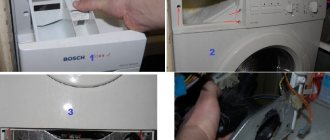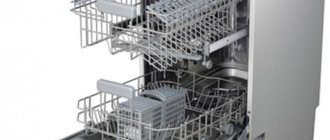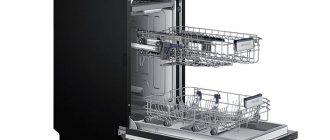Manufacturers advise cleaning your car about once a month. But this is a general recommendation. In your case, you may need to wash the device more often or less often. It depends on how exactly you are used to using the device.
Please note that the car gets dirty faster if:
- you turn it on once a day or more often;
- forget to leave the door open after washing (in this case, the internal elements of the machine take longer to dry and mold may appear on them);
- your water is too hard, but you forget to add special softening salt for the dishwasher to the compartment provided for this;
- load very dirty dishes - with burnt food, congealed fat, dried pieces of dough;
- run the wash at a low water temperature (for example, to save energy);
- are accustomed to using only gentle detergents that are simply not capable of removing serious stains;
- Place dishes that are not dishwasher safe, such as disposable or wooden ones, into the chamber.
However, even under such harsh operating conditions, the machine is able to remain clean for a long time. You can determine when it’s time to wash it based on certain signs.
How to know when it's time to clean your dishwasher
Here are a few main symptoms:
- Unpleasant odor from the working chamber.
- Poor dishwashing: plates, pots, and cups end up with whitish water stains or a greasy residue.
- Food particles are observed inside the chamber or on dishes removed from it.
- Rust and mineral deposits are visible on the internal surfaces of the tank.
- An indelible coating is visible on the filter and water spray blades.
- You notice that the water drains slower than usual or begins to leak.
If any of these signs appear, the car clearly needs a comprehensive cleaning. Be consistent.
Why might you need to remove the cover?
Removing the top cover may be necessary in several common cases, including:
- when integrating the device into a kitchen set;
- when repairing faults.
Let's take a closer look at each of the reasons. In many ways, the first reason can arise from a hasty choice. The incorrectly measured distance from cabinet to cabinet, as well as the height, and the dishwasher no longer fits into the kitchen set.
Of course, this problem can only be solved if you remove the top cover of the dishwasher. But it may not be resolved if the lid is not removed. Therefore, carefully consider the choice and parameters, but this is a completely different story. But it should be noted that if the height of the dishwasher is not suitable, then you can simply adjust the height of the legs of the set.
In the second case, everything is also clear, because when during repairs it is necessary to replace a part, you must first get it out. Of course, at the behest of the pike, it will not be replaced on its own, and in order to get it, you need special skills. First, you need to remove the cover, which is what we are talking about.
How to Clean Dishwasher Baskets
Photo: Vladyslav Lehir / Shutterstock
Baskets are those lattice trays on which dishes are placed. Food debris, especially in the form of long fibers, and fat can accumulate on them.
What you will need
- Latex gloves.
- Soft microfiber cloths.
- Sponge for washing dishes.
- An old toothbrush with soft bristles.
- Cleaning solution. The easiest way to prepare it is to dissolve a couple of tablespoons of dishwashing liquid in a liter of warm water.
- Pure water.
What to do
Remove the baskets from the guides, if possible, and soak them in the cleaning solution for a few minutes. Fixed elements will have to be washed directly in the car, pushing them out as far as possible.
Remove any large food debris. Then use a sponge to thoroughly wipe the grates on all sides. Use a toothbrush to clean hard-to-reach areas in the crooks of the baskets.
Shot: @Miss Clean / YouTube
Rinse the baskets with clean water. Wipe with tissues to remove excess moisture. Reinstall the parts if you removed them.
How to clean dishwasher filters
Some manufacturers recommend cleaning these elements after each dishwashing. The fact is that the filter system traps food particles to prevent them from clogging the drain. If this debris is not removed promptly, it decomposes and can cause an unpleasant odor. In addition, dirty filters make it difficult to drain water from the machine.
What you will need
- Latex gloves.
- Soft microfiber cloths.
- Screwdriver - optional.
- Sponge.
- Dishwashing liquid.
What to do
Unplug the dishwasher and close the water supply valve.
Pull out the strainer. It is usually located on the bottom panel of the dishwasher, next to the water spray blades.
Shot: @Oleg Home&Family / YouTube
If you have a modern dishwasher, removing the filter will not be difficult: just pull it up a little or unscrew it. On older models, you may need to use a screwdriver.
Shot: @Oleg Home&Family / YouTube
Inspect the filter for contamination. Remove any larger pieces of food and other debris, such as pieces of plastic utensils.
Rinse the part under warm running water. If the parts have a lot of grease, use a sponge and dishwashing detergent.
Blot the clean filter with an absorbent cloth to remove excess moisture and reinstall. Make sure that the marking arrows on the bottom of the dishwasher and on one side of the part point to each other after installation.
Failures in which the dishwasher leaks into the tray and the leakage protection system turns on
Three classes of malfunctions lead to Aquastop operation:
- internal leaks of the dishwasher (connections of pipes and hoses, washing chamber, etc. leak directly into the tray);
- external leaks, when their scale is large enough (for example, a damaged drain hose or dishwasher door flows onto the floor, and water flows from the floor into the pan);
- failure of the leakage protection system itself or the electronics associated with it.
Each of the faults is discussed in detail in the list of faults below.
The seal of the washing tank cup (sump with filters) has worn out - from 1800 rubles.
Therefore, the bottom of the washing chamber has lost its tightness, and water leaks into the tray during washing.
This malfunction is often found in Bosch and Siemens dishwashers with a service life of more than 5 years.
Signs
The dishwasher leaked from under the glass of the washing tank during washing, and Aquastop worked.
How to fix
The rubber seal on the cup needs to be replaced.
For some brands of dishwashers, repair kits with seals are not sold, so you have to replace the tank cup assembly.
Note! RemBytTech specialists use sealant only as a last resort, since it does not provide long-term reliable sealing, and after some time a repeated leakage will occur.
Leaking connections of pipes, hoses and pumps - from 1900 rubles.
Structurally, modern PMMs have two pumps (drain and recirculation), a three-way valve that switches the water flow during washing and to drain, a settling tank (glass) where filters are located, a tank for salt and resin (ion exchanger), etc. All these units are connected by pipes and hoses. It is the places where they connect that most often leak. However, leaks can also occur in any other places in the flood, circulation or drain paths.
Signs
The dishwasher leaked from under the glass of the washing tank during washing, and Aquastop worked.
How to fix
The technician checks the water fill, circulation or drain paths to detect the location of the leak. Based on the diagnostic results, clamps are tightened and seals or seals are replaced. If the pipes and/or hoses are damaged, they are replaced with new ones.
The drain hose is leaking - from RUB 1,500.
It has become disconnected or damaged. When there is an internal leak, the Aquastop system always works. If the leak is external, then everything depends on its scale. For example, if the hose is disconnected at the connection to the sewer, water after washing will pour out onto the floor and, most likely, will flood the tray with the Aquastop sensor. If the damage to the hose occurs outside the dishwasher, and it is minor, the hose will leak slightly onto the floor when draining, but the pan will not flood.
Signs
When draining, Aquastop may be triggered and/or water may appear on the floor.
How to fix
If the hose is damaged, the technician replaces it with a new one. When disconnected, it is fixed in its original place.
Filters are clogged - from RUB 1,300.
The washing tank overflowed due to poor water circulation due to filters clogged with food debris.
Signs
The leakage protection system was activated during the washing process. The dishwasher may also be leaking at the corners of the door.
How to fix
The dishwasher filters need to be cleaned.
Corrosion and leaks in the washing tank - from 1300 rubles.
In PMMs with a long service life, the washing tank usually rots in the stamping areas near the pan glass.
Signs
There is a leak during the wash cycle, the leakage protection has activated.
How to fix
The tank needs to be replaced.
If the hole is small and the scale of corrosion is small, there is the option of sealing the washing compartment with a high-temperature sealant. With such repairs, the dishwasher can last another 3 months to 2 years.
In general, with such leaks, you should think about buying a new car.
Cracked salt tank or heat exchanger canister - from 2000 rubles.
After use, there is always water left in the PMM: in the salt tank, in the heat exchanger canister and other components. If such a machine is left for a long time in a room with a negative temperature, the water will freeze, and the plastic vessels and hoses that contained water may burst.
Signs
The dishwasher, which was in the cold, leaked while washing or while drawing water. Aquastop worked.
How to fix
The salt tank, heat exchanger canister and other damaged components need to be replaced.
Faulty pressure switch - from 1600 rubles.
The level sensor itself has failed or the pressure sampling chamber or pressure switch tube is dirty. As a result, overflow occurs and leakage protection is activated.
Signs
The Aquastop system turned on while filling the dishwasher with water.
How to fix
The technician rinses the pressure sampling chamber and blows out the level sensor tube.
If the sensor itself malfunctions, a complete replacement of the pressure switch is necessary.
The Aquastop sensor has failed - from 1900 rubles.
Incorrectly reports a leak.
Signs
The dishwasher shows the Aquastop error, although there is no water in the pan.
How to fix
The sensor needs to be replaced.
The control module is faulty - from 2500 rubles.
The Aquastop controls in the module do not work correctly.
Signs
The dishwasher shows the Aquastop error, although there is no water in the pan.
How to clean dishwasher spray arms
Sprayers, or spray arms, ensure the flow and uniform distribution of water inside the dishwasher chamber. If they are clogged, the dishes will not be washed properly: stains and greasy marks will remain on them.
What you will need
- Latex gloves.
- Tweezers or toothpick.
- Microfiber cloths.
- Sponge.
What to do
Carefully inspect the openings (nozzles) of the spray arms from which water flows for contamination.
Shot: @Oleg Home&Family / YouTube
If you see dirt or food debris, try removing it with tweezers or a toothpick. But under no circumstances push debris into the nozzles!
If the parts are heavily soiled, remove the lower and upper nozzles as indicated in the machine instructions. Most often, the upper blade unscrews, and the lower one can be removed by simply gently pulling it up.
Rinse parts under warm running water, using a sponge if necessary. Then wipe the blades with napkins and put them in place.
Why is dismantling necessary?
When it comes to dismantling the top panel, only stationary (free-standing) models are considered.
Question answer. – Is the cover removable in the built-in PMM? - Can't be removed.
Typically, the height of a machine installed in a stationary manner is 85 cm. If the height of the PMM coincides with the height of the table top, the machine will not fit under it, since the height of the material is at least 3 cm. Removing the top cover is the best idea in this case. It is important that such a possibility is structurally provided for - not every model implements such a possibility. Take a look at the operating instructions - this will be indicated on one of the pages.
On a note! If the countertop is different from the standard one and is a few centimeters short, think about remodeling the kitchen. The easiest way is to lift the headset using the legs. You can replace the console by selecting a suitable height.
If you find out that you can remove the lid on your dishwasher model, remove it to gain 2.5–3 cm of free space, and it is likely that the appliance will fit successfully under the countertop. Following the advice of service center experts, it is worth additionally insulating the machine from moisture penetration during this installation. This will protect you from electric shock and the machine from burning out.
How to clean seals and dead spots in your dishwasher
Grease, food debris and other debris accumulate not only on filters and open surfaces of the device, but also in hard-to-reach places. For example, on the rubber gaskets between the door and the body.
In addition, debris can get into the lower part of the door - the so-called dead zone, where water does not penetrate during washing. This may cause an unpleasant odor.
What you will need
- Latex gloves.
- Dishwashing liquid.
- Sponge.
- Toothbrush with soft bristles.
- Microfiber cloths.
- Water.
What to do
Carefully inspect the seals and the bottom of the door. Remove large, visible debris.
Then wipe the elements with a sponge with detergent applied to it. If dirt is difficult to reach, use a toothbrush.
Wash the seals and the “dead zone” with a cloth soaked in clean water. Wipe dry.
Checking and replacing the pump
If your Bosch dishwasher does not drain water and you cannot hear the sound of the pump running, you will have to check and possibly replace this part. For this:
- Remove water from the PMM chamber in any convenient way.
- Remove the drain filter.
- Place the machine on its side.
- Remove the pan and disconnect the Aquastop system sensor from it.
- Remove the pump and disconnect the pipes from it.
- Check the impeller (it should rotate freely). If it jams, replace the pump.
- Check the resistance at the pump contacts with a multimeter. It should be within 200 Ohms if the pump is working properly. Otherwise, the pump must be replaced.
- Make sure that the pump is receiving voltage from the control unit. If not, the ECU may be faulty.
Removing the pump for diagnostics and replacement
In conclusion, I would like to note that it is better to entrust the diagnosis and replacement of such faulty parts as the pump, pressure switch and computer to qualified technicians. They have the experience and the necessary equipment to check, and you won’t have to look for original spare parts for repairs.











